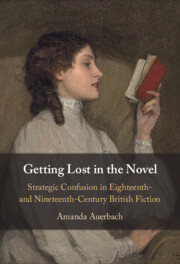Refine search
Actions for selected content:
7 results
Chapter 1 - Ending Up Alone with a Man in the Eighteenth-Century Marriage-Plot Novel
- from Part 1 - “Psychological” Subgenres
-
- Book:
- Getting Lost in the Novel
- Published online:
- 26 July 2025
- Print publication:
- 07 August 2025, pp 27-53
-
- Chapter
- Export citation
Introduction
-
- Book:
- Getting Lost in the Novel
- Published online:
- 26 July 2025
- Print publication:
- 07 August 2025, pp 1-24
-
- Chapter
- Export citation

Getting Lost in the Novel
- Strategic Confusion in Eighteenth- and Nineteenth-Century British Fiction
-
- Published online:
- 26 July 2025
- Print publication:
- 07 August 2025
Chapter 1 - Finance Capital and the Value Form of Character in Anthony Trollope’s Palliser Series
- from Part I - From Victorian Character to Modernist Professional
-
- Book:
- Modernism and Finance Capital
- Published online:
- 12 December 2024
- Print publication:
- 19 December 2024, pp 38-54
-
- Chapter
- Export citation
Chapter 4 - Reading Character in the Country and the City in Tess of the D’Urbervilles
- from Part II - Finance Capital and the Economic and Cultural Turn toward London
-
- Book:
- Modernism and Finance Capital
- Published online:
- 12 December 2024
- Print publication:
- 19 December 2024, pp 85-93
-
- Chapter
- Export citation
9 - Popular Romance and Literary Undergrounds
- from Part II - African American Genres
-
-
- Book:
- The Cambridge Companion to Contemporary African American Literature
- Published online:
- 14 December 2023
- Print publication:
- 21 December 2023, pp 164-178
-
- Chapter
- Export citation
Chapter 4 - Indulekha, or The Many Lives of Realism at the Fin de Siècle
-
-
- Book:
- Nineteenth-Century Literature in Transition: The 1890s
- Published online:
- 17 August 2023
- Print publication:
- 07 September 2023, pp 78-96
-
- Chapter
- Export citation
